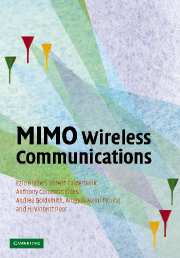Book contents
5 - Fundamentals of receiver design
Published online by Cambridge University Press: 15 December 2009
Summary
Introduction
This chapter is devoted to MIMO receivers, with special focus on single-user systems and frequency-flat channels (multi-user systems and more general channels will be the subject of the next chapter). We start with a brief discussion of uncoded MIMO systems, describing their optimum (maximum-likelihood, ML) receivers. Since these may exhibit a complexity that makes them unpractical, it is important to seek receivers that achieve a close-to-optimum performance while keeping a moderate complexity: these would remove the practical restriction to small signal constellations or few antennas. Linear receivers and receivers based on the sphere-detection algorithm are examined as possible solutions to the complexity problem. Next, we study iterative processing of received signals. We introduce here the idea of factor graphs. Their use offers a versatile tool, allowing one to categorize in a simple way the approximations on which MIMO receivers and their algorithms are based. In addition, they yield a “natural” way for the description of iterative (turbo) algorithms, and of their convergence properties through the use of EXIT-charts. Using factor graphs, we describe iterative algorithms for the reception of MIMO signals, along with some noniterative schemes that can be easily developed by using the factor-graph machinery.
A basic assumption in this chapter is that channel state information (i.e., the values taken on by all path gains) is available at the receiver, while the transmitter knows the channel distribution (i.e., the joint probability density function of the channel gains). In addition, the channel is quasi-static (i.e., it remains constant throughout the transmission of a whole data frame or codeword), and the transmitted signals are two-dimensional.
Information
- Type
- Chapter
- Information
- MIMO Wireless Communications , pp. 186 - 229Publisher: Cambridge University PressPrint publication year: 2007
